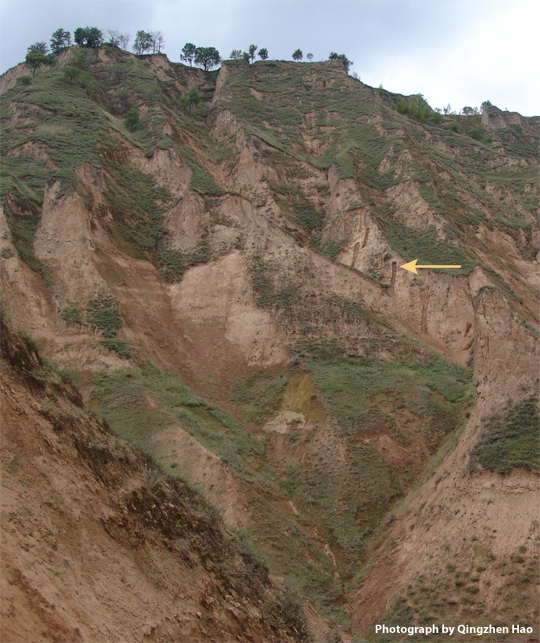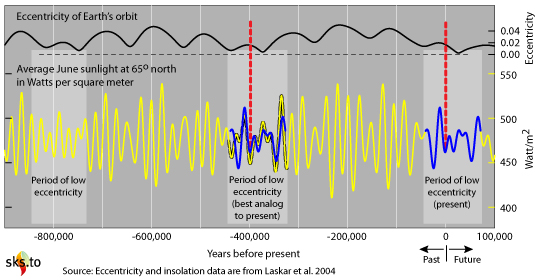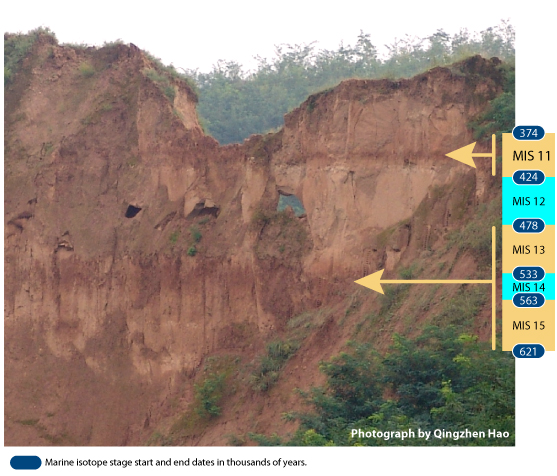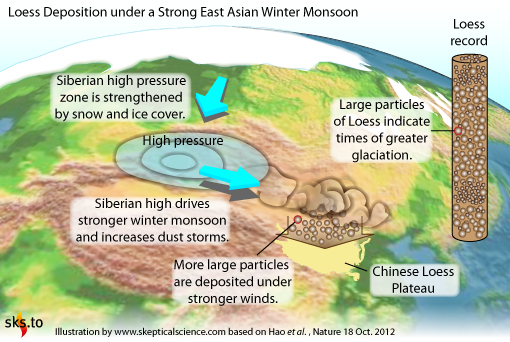The Dirt on Climate
Hao et al.* (Nature, 18 Oct 2012) has provided an estimate of the duration of Northern Hemisphere glaciations by digging into wind-blown dust deposits, called loess (pronounced "luss"). This work improves our understanding of the timing of the rise and fall of Arctic ice sheets over the past 900,000 years and provides evidence that our current interglacial, the Holocene, could have continued for another 40,000 years, even without an increase in greenhouse gases.
Humanity's industry has interrupted the Holocene, rendering moot the question of how long the Holocene would have lasted, but understanding what we are about to interrupt may help restore our conservative side—conservative in the sense of wanting to keep what we have.
What type of climate have we interrupted? Early climate science suggested that due to Earth's response to variations in orbit, Earth could be transitioning into the next ice age. Recent studies have the advantage of palaeoclimate reconstructions, such as this one based on 57 ocean sediment cores (Lisiecki and Raymo, Paleooceanography 2005), allowing us a better look at past climates:

Figure 1: From Lisiecki and Raymo 2005, a comparison of global temperatures based on changes in 18O in ocean sediments with marine isotope stages inferred from this record. The adjustment to MIS 10 and 11 is from Hao et al. More data extending to 1 million years ago are available as a larger image. Click the figure to see the larger image.
Antarctic ice and ocean sediments provide ample evidence of Earth's drastic mood swings between glacial and interglacial climates. Yet these records are incomplete. Scientists focus on uncertainties, that is, questions not answered by these data. For example, neither Antarctic ice nor ocean sediments provides a complete picture of northern hemisphere because
- ocean sediments reflect the global ice sheet balance, and
As there is no Northern Hemisphere counterpart to the million year span of Antarctic ice, loess can help us fill in this gap. Extending back millions of years, Loess reveals the Northern Hemisphere during times when orbital parameters could have created Holocene-like climates.

Figure 2: Loess deposit. The vertical dimension shown spans approximately 150 meters and the arrow marks one of many vertical gouges where loess was removed by Hao et al. for palaeoclimate analysis. The photograph and its explanation were provided by Qingzhen Hao.
Orbital Time Scales
For estimating the span of the Holocene, the ideal time periods to examine would be 400,000 and 800,000 years ago when Earth was in periods of low orbital eccentricity similar to that which started the Holocene. Figure 3 illustrates the comparison made by Hao et al., showing similarities in eccentricity and sunlight (insolation) at 65 degrees north. The current period of low eccentricity (blue) is overlaid on the period 400,000 years ago.

Figure 3 illustrates a comparison made in Hao et al.: Eccentricity (black) and insolation at 65 degrees north (yellow) are shown from 900,000 years ago to 100,000 years in the future. Blue represents the time period from -40,000 to + 80,000 and is overlaid on a period 400,000 years ago, the nearest time period best matching Earth's current orbit. Orbital data are from Laskar, J., Robutel, P., Joutel, F., Gastineau, M., Correia, A.C.M., Levrard, B.: 2004, A long term numerical solution for the insolation quantities of the Earth.
The time period 400,000 years ago is the best example to compare to the present for two reasons: 1) it has insolation values similar to current, and 2) 400,000 years ago is well after the late Pleistocene transition, a shift in the timing of glacial cycles from 41,000 years to 100,000 years.

Figure 4: Loess showing variations in climate. The darker red bands are palaeosols deposited during warmer periods 400,000 years ago (upper band) and 500,000—600,000 years ago (lower band). The photograph and its explanation were provided by Qingzhen Hao.
Reading the Dust
The age of loess deposited on the Chinese Loess Plateau spans millions of years and reflects major climate transitions that occurred at 2.7, 1.8, and 0.9 million years ago. The 100,000-year glacial to interglacial cycle is also shown in the Loess. Using loess as a measure for these glacial cycles relies on a relationship between snow and ice cover in Eurasia, the strength of the Siberian High Pressure system, and the occurrence of dust storms that have deposited the loess.
Two weather systems leave their marks on records from the Chinese Loess Plateau: The East Asian Winter Monsoon and the East Asian Summer Monsoon. As suggested by their names, each climate system dominates during cold or warm seasons. A typical winter monsoon will bring cold dry air from the north and generate dust storms that deposit loess marked by larger particle size. In contrast, the Summer Monsoon blows from the south, and when it is strong, soil formed on the loess plateau contains finer particles called palaeosols.

Figure 5: Loess deposition under a strong East Asian Winter Monsoon. The tan area is the Chinese Loess Plateau redrawn from supplemental references of Hao et al.
The strengths of the Winter and Summer monsoons relative to each other can vary over decades, centuries, or millennia, with a corresponding effect on the particle size found in accumulated loess. The loess can also be examined for changes in iron content. This measurement provides a reality check on the dating of the age of the loess, for it tracks closely with the ocean core record. Yet, at the previous time periods of low eccentricity, the dust particle size (proxy of winter activity and northern hemisphere glaciation) is delayed. What could be going on? It is noteworthy that these variances in the loess occur only at the low eccentricity periods. If they were randomly distributed or always off, we could suspect that the proxy is unreliable or suffers from some measurement error. But if the variance is consistent with other possibilities, then we can consider it a valid piece of our picture of climate during low eccentricity.
Climate models suggest a plausible explanation: The Antarctic ice sheets could have built up before the Northern Hemisphere succumbed to glaciations. This build up could have been in sufficient quantities to affect the marine isotope record and the iron content, while allowing the continuation of interglacial climate in the northern hemisphere.
Conclusions
The particle size of loess suggests that the East Asian Winter Monsoon did not reach typical glacial strength until 20,000 years after the onset of glaciations inferred from Antarctic ice and ocean sediments. If the Holocene was heading toward a similar delay of Northern Hemisphere glaciations, then our next glacial climate would be another 40,000 years in the future.
With industrialization, humanity was given an opportunity to improve our lives and productivity before understanding the costs. Part of understanding the costs is in appreciating what we had. If global warming were countering an imminent ice age, we could consider our CO2 emissions helpful. On the other hand, if we could know that we were in the middle of the civilization-friendly Holocene, then our disturbance of this climate may be regrettable. The life span of the Holocene is an old question, but it remains relevant in palaeoclimate studies.
I'd like to thank Qingzhen Hao for his assistance and photographs.
* Nature, 18 Oct 2012. Delayed build-up of Arctic ice sheets during 400,000-year minima in insolation variability. Qingzhen Hao, Luo Wang,Frank Oldfield, Shuzhen Peng, Li Qin, Yang Song, Bing Xu, Yansong Qiao, Jan Bloemendal & Zhengtang Guo
Posted by jg on Wednesday, 2 January, 2013






